Finally, we have the top model of the AMD Ryzen 5 launch series, the AMD Ryzen 7 1600X. This is a really interesting CPU. In terms of specs, it is a 6 core 12 thread part with 16MB L3 cache and a 95W TDP. Immediately that gives it an advantage in a market where the average consumer space PC has, at most, 4 cores and 8 threads. While a lot of sites are pitting the AMD Ryzen 5 1600X against competition from Intel, we have the full Ryzen 5 and Ryzen 7 lineups to pit the CPU against. In our view, the AMD Ryzen 5 1600X is a great CPU, but it struggles in the value department against AMD’s other CPU offerings. With a dozen test systems set up, mostly for DemoEval, and running and over a month worth of hours on the clock with Ryzen, we have a good idea regarding where value lies in the continuum.
Test Configuration
For our Ubuntu 14.04 with kernel 4.10.1 benchmarks we standardized on a very simple platform.
- CPU: AMD Ryzen 5 1600X
- Motherboard: ASUS Prime B350-Plus
- RAM: 16GB (4 x 16GB) DDR4-2666
- Boot Media: Intel DC S3710 400GB
- Cooling: Noctua NH-L9x65 SE-AM4
- Operating System: Ubuntu 14.04 LTS with Kernel 4.10.1
We expect most 1600X users will opt for a X370 motherboard. Our benchmarks are done using one of our B350 platforms, but after some time we thought that buyers are most likely going to use an X370 motherboard like the ASRock X370 Killer SLI/ac Motherboard Review or the ASUS Prime X370-Pro pictured below. After testing the entire SKU stack, we added our Ryzen 5 1600X to the ASUS.
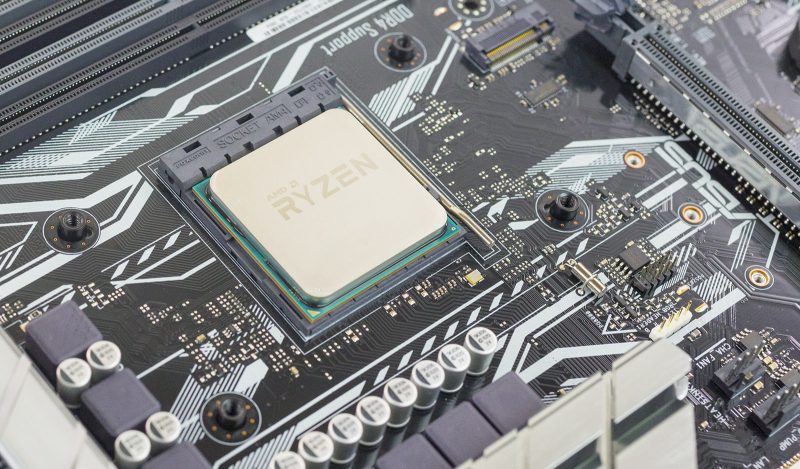
The picture above is also one of the reasons we find the AMD Ryzen 5 1600X to be lacking in value. Compared to the AMD Ryzen 5 1600 there is no included cooling solution. Instead, one is stuck purchasing an aftermarket solution such as the Noctua NH-L9x65 SE-AM4 which will run $45 or so.

Why the is important is because the AMD Ryzen 5 1600X moves from a $30 upgrade over the Ryzen 5 1600 to a $70 upgrade. Likewise, the MSRP may look like a $80 savings over the Ryzen 7 1700, but when a modest cooler is added it is $40 savings. We called the Ryzen 5 1600 our best value in the Ryzen 5 lineup. As you will see below, it is slightly slower than the 1600X but at $70 less. Likewise, if we were spending $289 on a CPU and cooler, spending another $40 or 14% more to get 33% more cores and threads is an obvious choice. Compared to the average Intel 4 core offering, the Ryzen 5 1600X looks great, but one must look at the rest of the Ryzen range. We were fortunate in that STH was one of the only review sites to get to have completed testing of all Ryzen 5 and 7 SKUs before the Ryzen 5 launch. As a result, the value comparison strongly influenced our recommendations. We are going to have a more in-depth value analysis soon.
We recommend using Ryzen only with Linux kernels 4.10 and later. Ubuntu 17.04 will be out soon (scheduled for April 13, 2017) with kernel 4.10, however, if you want to use a Ubuntu LTS release here is the guide to stop constant crashing with Ubuntu and Ryzen. We linked the Ubuntu upgrade guide but if you are running Debian, RHEL, or CentOS 7 you will need to upgrade to a newer kernel ASAP. Here is the guide to stop the crashes in CentOS 7 by upgrading the kernel to 4.10.1 there.
Many of our readers need some sort of VMware support. Ryzen 5 like Ryzen 7 has significant issues in VMware ESXi 6.5. We did post a workaround involving a significant performance penalty. For now, we suggest using Windows 10 + VMware Workstation 12 Pro with Ryzen.
At the end of the day, if you are working on many different types of Linux software, or need to use certain kernels, the cost of Ryzen should include system preparation time.
AMD Ryzen 5 1600X Linux Benchmarks
For our testing we are using Linux-Bench scripts which help us see cross platform “least common denominator” results. We are using gcc due to its ubiquity as a default compiler. One can see details of each benchmark here. We are likely going to update the Linux-Bench in the near future with a few new tests as well as an even simpler to use/ faster revision, but for now, we are using the legacy version that now has over 100,000 test runs under its belt.
The item to remember here is that any benchmark we are publishing has had at least 10,000 profiling runs on a multitude of different architectures to ensure we get consistent results before we add it to our repertoire. Normally we go one step further and heat soak every machine at 100% load for 24 hours. On multi-node systems we even use a “sandwich” and controlled temperature and humidity to ensure systems are as close to real-world temperatures as possible. Due to the desktop nature of Ryzen chips, we are going to present our linux kernel 4.10.1 based results all with 24-hour heat soak but with no adjoining systems.
Python Linux 4.4.2 Kernel Compile Benchmark
This is one of the most requested benchmarks for STH over the past few years. The task was simple, we have a standard configuration file, the Linux 4.4.2 kernel from kernel.org, and make with every thread in the system. We are expressing results in terms of complies per hour to make the results easier to read.

This is a very cool picture if you use AWS instances to compile software. The payback period of a Ryzen 5 1600X entire system is likely to be under 60 days based on the AWS c4.4xlarge pricing. A higher-clocked Ryzen 5 1600X machine also out-performs a previous generation low power Intel Xeon E5-2630L V3 system.
One caveat here is that our Ryzen test system would peak around 134W while a HPE DL60 Gen9 1U server with screaming fans and a dual-port 40GbE adapter used only 73W. For those that use “cheap” data center power, that means a $15/mo or so additional operations cost for the Ryzen 1600X system or about six quarters to pay back the difference in purchase price. Used the E5-2630L V3 often sells for less than Ryzen 5 1600X but we are going to set that fact aside.
c-ray 1.1 Performance
We have been using c-ray for our performance testing for years now. It is a ray tracing benchmark that is extremely popular to show differences in processors under multi-threaded workloads.
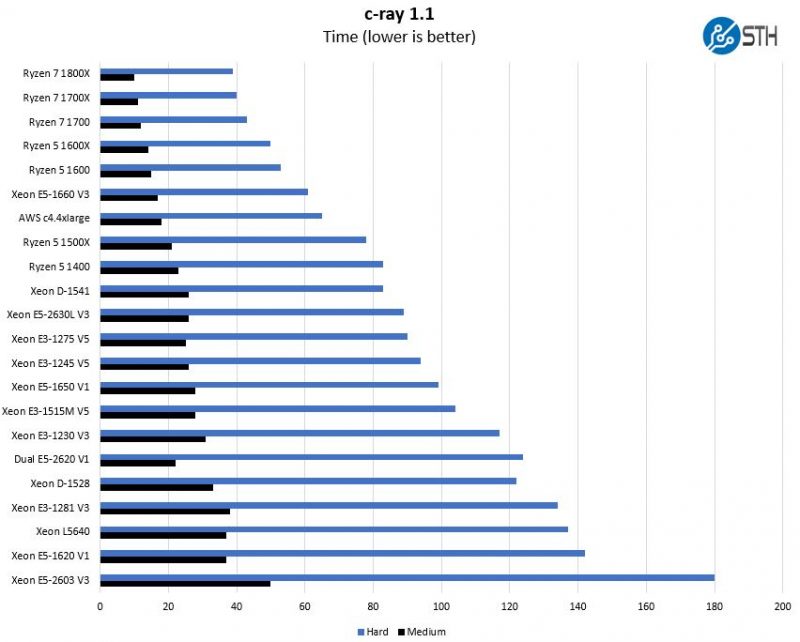
When you look at c-ray 1.1 results, it is a benchmark where Ryzen scores very well. Please do keep in mind that we have plenty of higher-end systems that are pushing the limits of our “hard” 4K render setting and can complete the same work in 6 seconds. The Ryzen chips are fast for single-socket midrange workstation platforms for sure.
7-zip Compression Performance
7-zip is a widely used compression/ decompression program that works cross platform. We started using the program during our early days with Windows testing. It is now part of Linux-Bench.
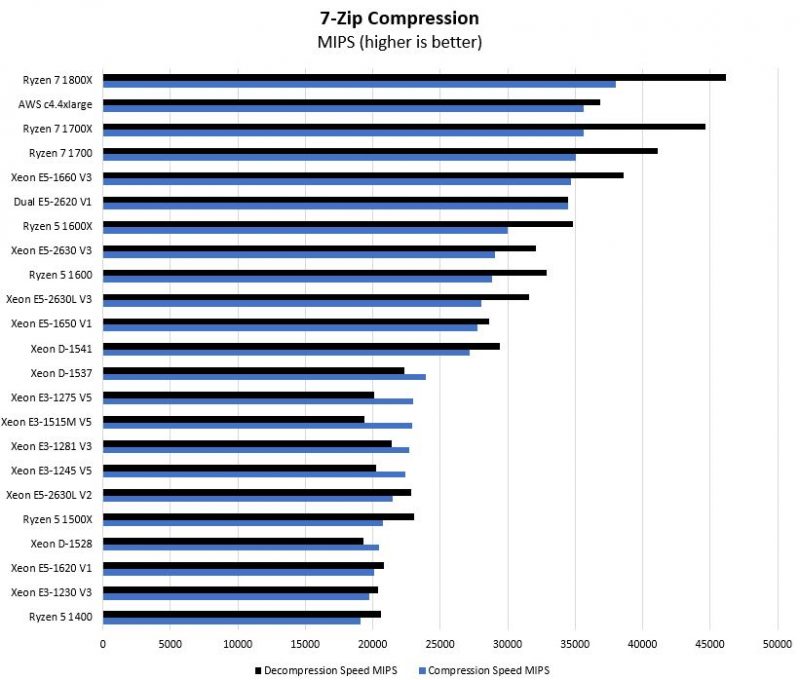
Six cores and high clock speeds help propel the AMD Ryzen 5 1600X to some great performance numbers in compression workloads.
NAMD Performance
NAMD is a molecular modeling benchmark developed by the Theoretical and Computational Biophysics Group in the Beckman Institute for Advanced Science and Technology at the University of Illinois at Urbana-Champaign. More information on the benchmark can be found here. We may replace this or augment with GROMACS in the next-generation Linux-Bench as that test is currently running through regressions.
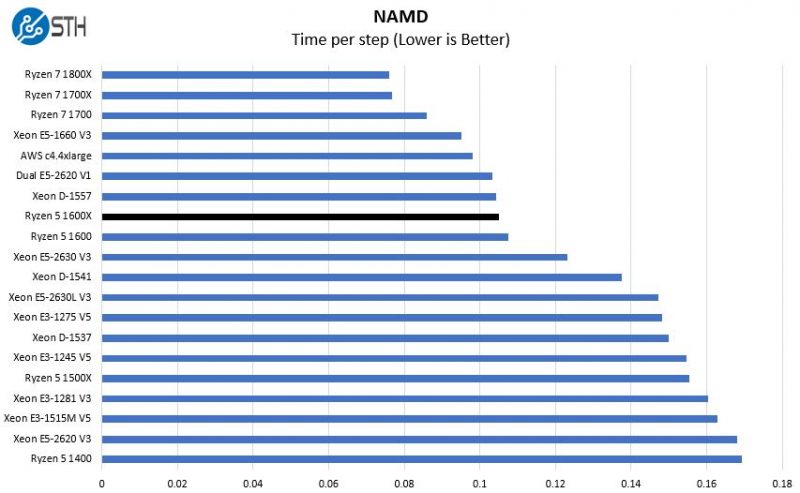
Our sense is that if you are doing this type of work, you will find the extra $40 to get significantly higher performance with the Ryzen 7 1700.
Sysbench CPU test
Sysbench is another one of those widely used Linux benchmarks. We specifically are using the CPU test, not the OLTP test that we use for some storage testing.
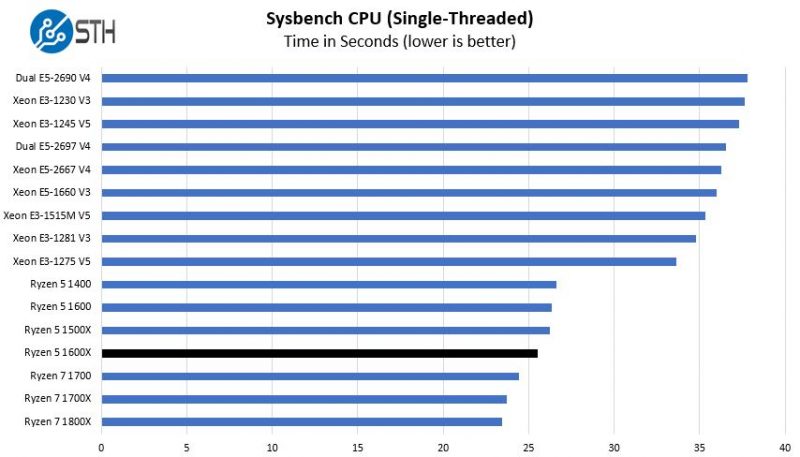
These results are very good. Many of the systems on there perform significantly better in multi-threaded workloads but the Ryzen systems perform very well int he single threaded tests.
OpenSSL Performance
OpenSSL is widely used to secure communications between servers. This is an important protocol in many server stacks. We first look at our sign tests:
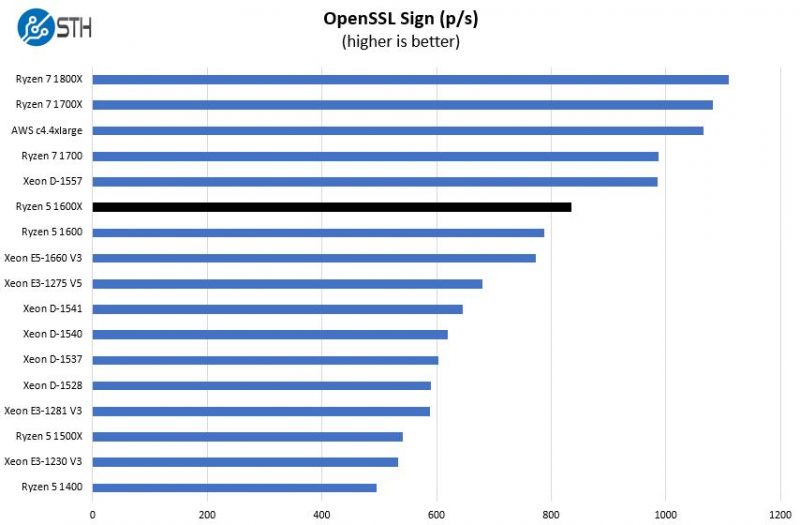
Here are the verify results:
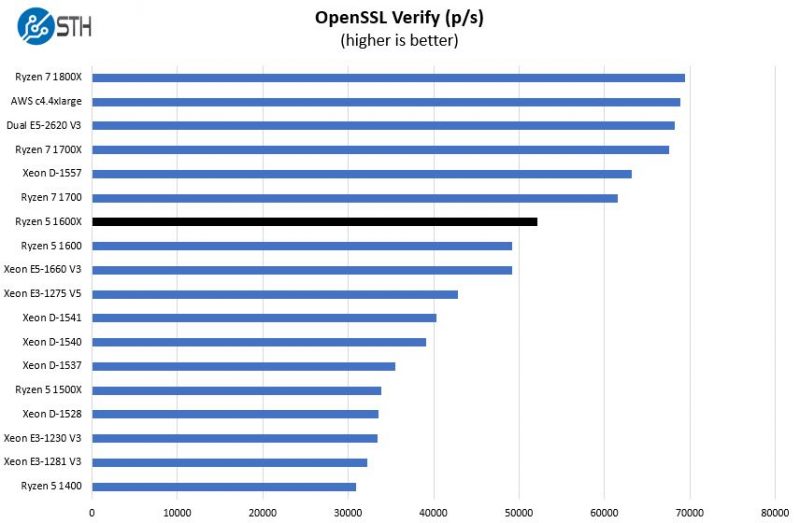
While one may look and declare a clear victory for the Ryzen over Skylake-based E3-1275 V5, do remember that this is at a power figure of about 50W higher and that E3-1275 V5 has a GPU included in the purchase price of only $70 or so more.
UnixBench Dhrystone 2 and Whetstone Benchmarks
One of our longest running tests is the venerable UnixBench 5.1.3 Dhrystone 2 and Whetstone results. They are certainly aging, however, we constantly get requests for them, and many angry notes when we leave them out. For example on our original AMD Ryzen 7 1700X review where UnixBench was crashing due to the kernel version we were using we left the results out and received many e-mails asking about them. UnixBench is widely used so it is a good comparison point.
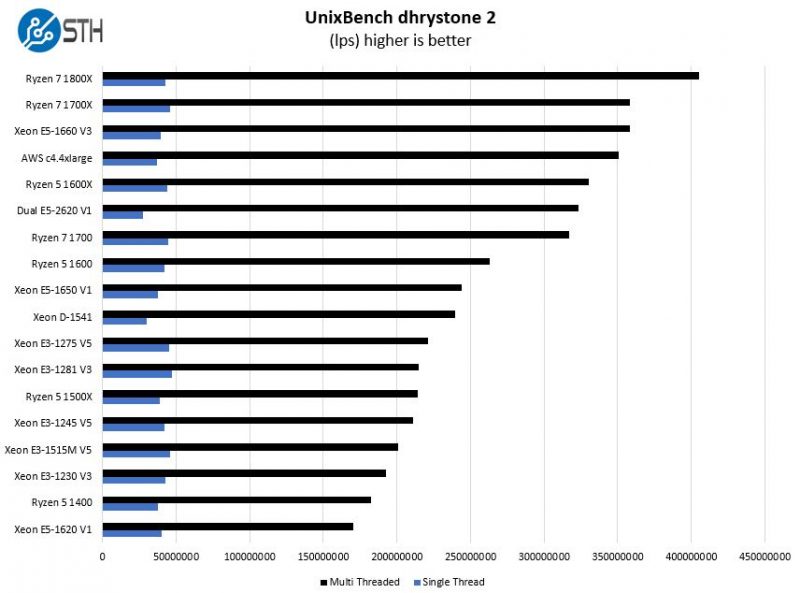
This is an example of where the AMD Ryzen 5 1600X and its high clock speed performs extremely well.
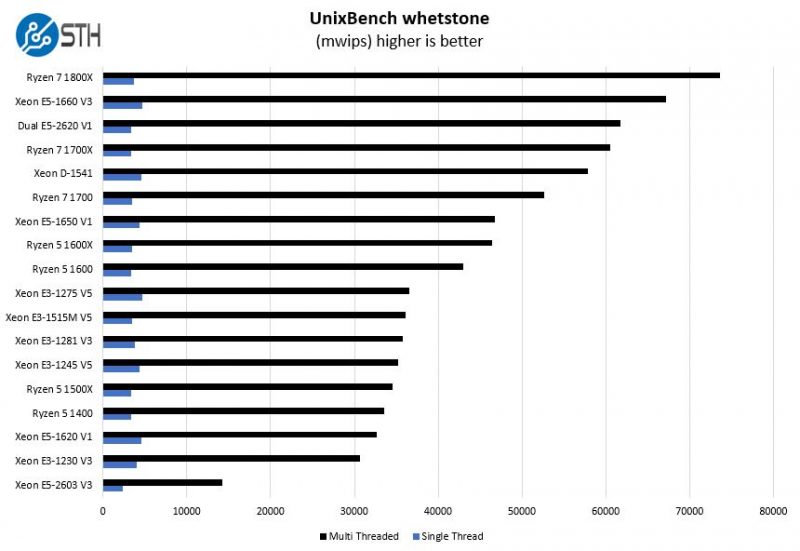
Here the Ryzen 5 1600X performs just between the 7 1700 and the 5 1600.
Final Words
Reading reviews at launch, there was a ton on the AMD Ryzen 5 1600X. AMD sampled many sites with the 1500X and 1600X so that they would, naturally, compare them to the Ryzen 7 line and Intel chips. One benefit we had was being able to buy our chips and test the entire 7 CPU line-up before the Ryzen 5 official launch. If you are using Windows or are okay with the potential Linux headaches, at 6 or 8 cores, AMD has something special. The hard part is recommending the Ryzen 5 1600X over the AMD Ryzen 5 1600 since that is a much better value. Likewise, if you are already building an X370 system, the marginal cost to upgrade to the Ryzen 7 1700 with the Spire RGB would make us think very hard before opting for the higher clock speed Ryzen 5 1600X.
This is one instance where it is not Intel’s line that causes us to say the chip is not a great value. Instead we are looking to AMD’s offerings higher and lower and the Ryzen 5 1600X is hard to justify as a good value. We expect many of the consumer platform sites to reach this conclusion as they get the Ryzen 5 1600.

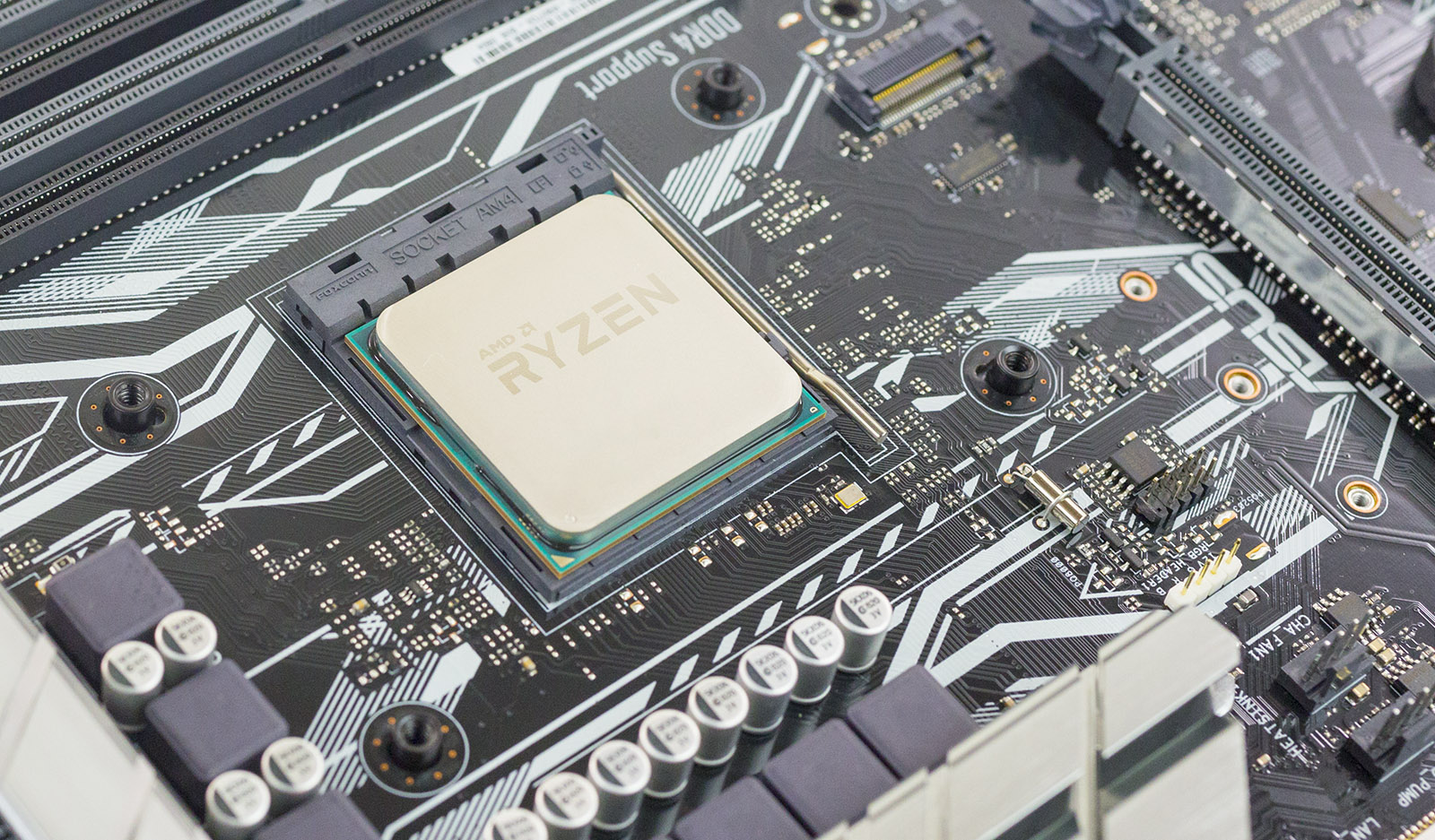



Patrick,
I may have missed something, but do you know that the “spec sheet” at the beginning of the article lists the 1600 and 1600X as quad-core processors rather than hexa-core (or if we keep with Latin sexa-core)?
SDLeary
Idiot Intel fanboy, did Intel pay you for this AMD shot?
1600X/1600 supports ECC and works on asrock board with 64GB at 2400Mhz. Slight underclock and you are drawing less power than an atom c2750 or c2550 processor.
I have 2 k4 asrock and 2 gaming pro boards, the supermicro atom board is getting sold on ebay soon.
So it should be
1600 INCREDIBLE VALUE, negative bs is just bs.
Thanks. A nice and informative review as always. I also like the new site design. Loads a lot faster on mobile.
I have one complaint though. What’s with the nasty comments, like the one above? Maybe leaving a comment is made a bit too easy?
Although BB’s tone is uncalled for, he makes a highly relevant point for those open to using Ryzen series CPUs in a server, as ECC support via an equivalently powerful Intel Xeon is much more expensive, thus this would be worth highlighting as an update to the article especially because AMD seem to severely underemphasise this key selling point.